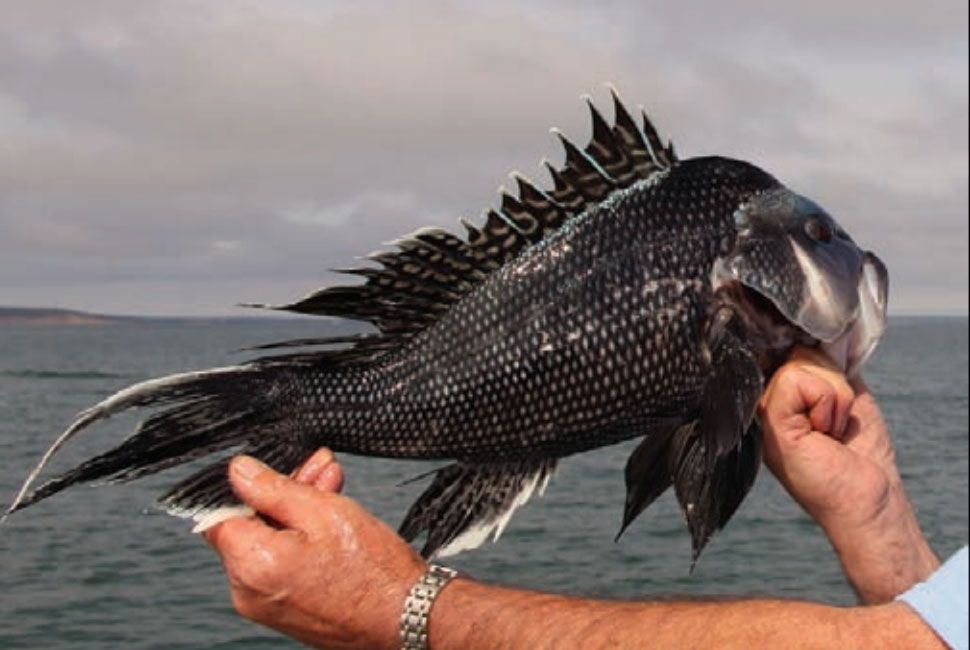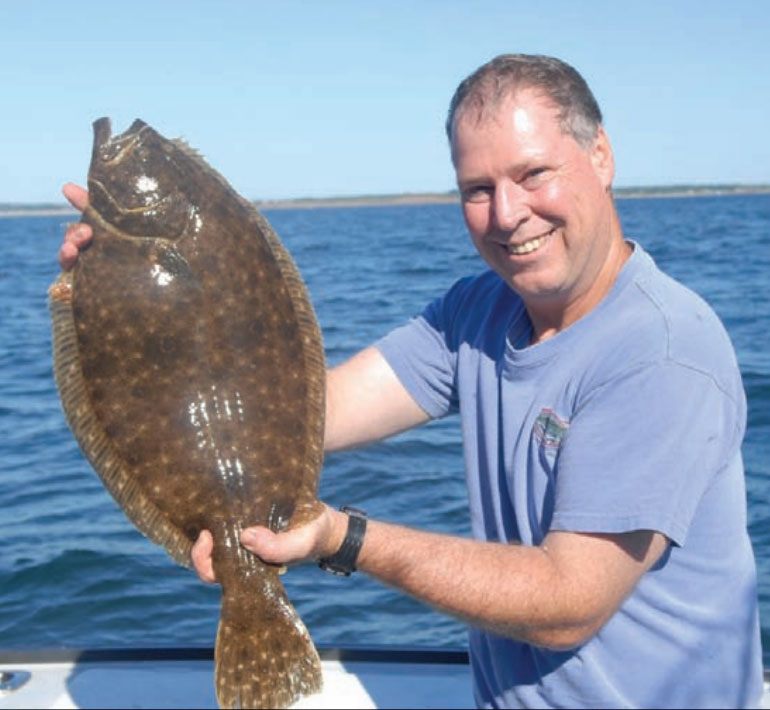BY TOM SCHLICHTER

Many fluke anglers believe that doormat fluke love big baits. I’m one of them, and reports I’ve taken over the years, along with my own log books, prove this theme holds water. For fluke weighing eight pounds or more, long strips of squid, sea robin and bluefish show up time and again in tales of trophy catches, especially during the first few weeks of the season.
No doubt it’s squid that generally lure the biggest fluke into our near-shore ocean, sound and bay waters. As the eightarmed cephalopods arrive on the scene in late April and May, you can bet the biggest fluke will be right on their tails. That being the case, it makes sense to give them what they crave, which is why long strips of thick and juicy local squid are probably your best bet overall for drilling that fluke of a lifetime.
GO LONG
If I’m really intent of catching big fluke, I’ll cut the longest stripbait possible. Some of the baits I’ve used to catch big fluke have measured over 12-inches in length. Usually, however, I’ll opt for a seven- to nine-inch pennant-shaped strip as these provide a good shot at big fish while still enticing quality keepers in the three- to four-pound class. Over the past few years I’ve also experimented with There was a time when I used to drag whole squid on the bottom for big fluke, but I’ve actually caught more bruisers in recent years using the double-strip technique. This approach saves bait in the long run, looks more alive in the water than a whole dead squid since the strips react to every twitch of the rod and, being less bulky, allows me to use slightly lighter tackle to keep my offering near the bottom. Whenever possible, I prefer fresh local squid because of its thicker flesh, cleaner scent, vivid color and added toughness, but frozen squid will suffice in a pinch.

COCKTAIL STRIPS
There are, of course, other options for making stripbaits. Sea robin is an obvious one. Use the brownish-red top strips over sandy bottoms and the white belly strips over dark bottoms as the contrast helps make your offering a little more visible. Cocktail blues are another option. Strips cut from small choppers seem to produce especially well when presented in rip waters. Other stripbait options include bunker, mackerel, tinker mackerel, croaker and even fluke strips cut from the belly of another keeper.
In terms of rigging, it’s best to keep things simple when targeting doormats with stripbaits. Start with a 24- to 30-inch length of 30-pound test mono leader material snelled to a single4/0 wide-gap or sproat style hook, then tie the leader into the main line via a dropper loop four inches above a four- to eight-ounce sinker. Avoid using spinners and flashy adornments as the may wrap around the line when the current gets pushing, and skip high-hook teasers as they tempt too many smaller fish. I keep my rigs completely unadorned except for a pearl or glow bead placed immediately above the hook, although I might add a chartreuse or hot pink skirt if fishing in discolored water.

DELAY AWAY
In terms of the way big fluke hit large strip baits, expect a fairly pronounced tap or the sudden addition of a substantial amount of weight at the end of the line. In either case, ease your rod tip down toward the water while taking up slack line, then lift gently until the rod is parallel with the water’s surface. If you still feel weigh at this point, pause for a count of five before setting the hook with a smooth, solid lift. That slight delay is key, for it guarantees a big fish has time to pass the baited hook beyond its toothy, bony jaws and back toward the more tender part of its mouth.
Hooking a doormat fluke is one thing; getting it into the boat is quite another. The biggest fluke simply hug the bottom at the start of the battle, then try to move off in powerful spurts that will test your knots and drag setting. If everything holds together, steady pressure will eventually bring the fish up from the depths providing a feeling of relief – and that’s where most anglers come up short. If you keep a tight line and glide the fish smoothly into a waiting net, all should go well. Lift the fish’s head out of the water for just a second, however, and it will respond with a violent head shake and sharp dive that often tears the hook free or simply breaks the line. Don’t be in a rush to get that fish up on deck. A tight line and smooth, steady cranking is the way to win this game.
As you read this, big fluke are already sliding into near shore waters up and down the Long Island and Connecticut coast. Keep in mind that the fish you’ll be targeting with this technique have the potential to be true trophies. Just because they are the crème of the crop, however, doesn’t mean you have to keep every one. Consider taking a photo and then tossing your next doormat back into the drink. By scaling down your presentation to use smaller baits, or working bucktails and soft plastics inside the bays, you can always go back to catching standard sized keepers that are perfect for the dinner plate.
BY TOM SCHLICHTER









